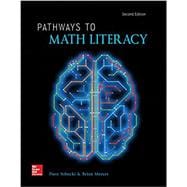Pathways to Math Literacy, 2nd Edition
Unit 1: Organizing and Visualizing Numeric Data
Lesson 1-1: Where Does the Time Go? (Percentages, Pie Charts, and Bar Graphs)
Objective 1: Analyze personal time management for a week of activities.
Objective 2: Solve problems involving percentages.Objective 3: Create and interpret pie charts.
Objective 4: Create and interpret bar graphs.
Objective 1: Analyze personal time management for a week of activities.
Objective 2: Solve problems involving percentages.
Objective 3: Create and interpret pie charts.
Objective 4: Create and interpret bar graphs.
Lesson 1-2: Do You Have Anything To Add? (Using Addition and Subtraction Skills) Objective 1: Identify circumstances where addition or subtraction is possible.
Objective 2: Add or subtract quantities.
Objective 1: Identify circumstances where addition or subtraction is possible.
Objective 2: Add or subtract quantities.
Lesson 1-3: It's About Accumulation (Using Multiplication and Division Skills) Objective 1: Interpret multiplication as repeated addition.
Objective 2: Multiply or divide quantities.
Objective 1: Interpret multiplication as repeated addition.
Objective 2: Multiply or divide quantities.
Lesson 1-4: Avoiding Empty Pockets (Using Exponents and Order of Operation) Objective 1: Distinguish between simple interest and compound interest.
Objective 2: Distinguish between linear and exponential growth.
Objective 3: Interpret exponents as repeated multiplication.
Objective 4: Simplify numeric expressions involving exponents and the order of operations.
Objective 1: Distinguish between simple interest and compound interest.
Objective 2: Distinguish between linear and exponential growth.
Objective 3: Interpret exponents as repeated multiplication.
Objective 4: Simplify numeric expressions involving exponents and the order of operations.
Lesson 1-5: A Coordinated Effort (The Basics of Graphing) Objective 1: Use a rectangular coordinate system.
Objective 2: Connect data to graphs.
Objective 3: Interpret graphs.
Objective 1: Use a rectangular coordinate system.
Objective 2: Connect data to graphs.
Objective 3: Interpret graphs.
Lesson 1-6: What are the Chances? (Basic Probability) Objective 1: Compute and interpret basic probabilities.
Objective 2: Translate a probability to a percent chance.
Objective 3: Recognize the difference between theoretical and empirical probability.
Objective 1: Compute and interpret basic probabilities.
Objective 2: Translate a probability to a percent chance.
Objective 3: Recognize the difference between theoretical and empirical probability.
Lesson 1-7: Debt: Bad, Chocolate: Good (Using Scientific Notation) Objective 1: Convert numbers between decimal and scientific notation.
Objective 2: Describe the significance of writing numbers in scientific notation.
Objective 1: Convert numbers between decimal and scientific notation.
Objective 2: Describe the significance of writing numbers in scientific notation.
Lesson 1-8: What's Your Type? (Organizing Information with Venn Diagrams) Objective 1: Analyze how your personality type affects how you interact with others.
Objective 2: Create and interpret Venn diagrams.
Objective 3: Describe sets using appropriate terminology.
Objective 1: Analyze how your personality type affects how you interact with others.
Objective 2: Create and interpret Venn diagrams.
Objective 3: Describe sets using appropriate terminology.
Lesson 1-9: News in the Data Age (Gathering and Organizing Data) Objective 1: Explain the difference between a population and a sample.
Objective 2: Organize data with frequency distributions and histograms.
Objective 3: Analyze data with stem and leaf plots.
Objective 1: Explain the difference between a population and a sample.
Objective 2: Organize data with frequency distributions and histograms.
Objective 3: Analyze data with stem and leaf plots.
Unit 2: Making Sense of It All
Lesson 2-1: Did You Pass the Test? (Using Measures of Average) Objective 1: Consider strategies for preparing for and taking math tests.
Objective 2: Understand the impact of a single question, or a single exam.
Objective 3: Calculate, interpret, and compare measures of average.
Objective 1: Consider strategies for preparing for and taking math tests.
Objective 2: Understand the impact of a single question, or a single exam.
Objective 3: Calculate, interpret, and compare measures of average.
Lesson 2-2: Ins and Outs (Inputs, Outputs, and Interpreting Expressions) Objective 1: Distinguish between inputs (independent variables) and outputs (dependent variables).
Objective 2: Evaluate expressions and formulas.
Objective 3: Write and interpret expressions.
Objective 1: Distinguish between inputs (independent variables) and outputs (dependent variables).
Objective 2: Evaluate expressions and formulas.
Objective 3: Write and interpret expressions.
Lesson 2-3: From Another Dimension (Working with Units and Formulas) Objective 1: Determine units for area and volume calculations.
Objective 2: Use formulas to calculate areas and volumes.
Objective 3: Discuss important skills for college students to have.
Objective 4: Simplify expressions.
Objective 1: Determine units for area and volume calculations.
Objective 2: Use formulas to calculate areas and volumes.
Objective 3: Discuss important skills for college students to have.
Objective 4: Simplify expressions.








